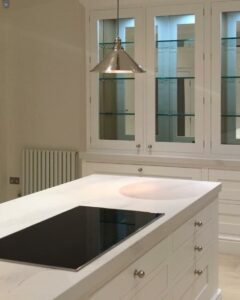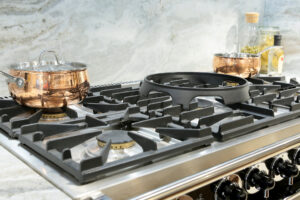Is a GAS hob or Induction hob a better option for your dream kitchen? …the debate is certainly heating up!
- News
- August 20, 2016
The question of which is better with regards to a gas or induction hob is a question being asked more and more frequently by our customers. For anyone not familiar with the kitchen industry, the induction hob may be something you have never really given much thought to. But their must be a justification for the rapidly increasing number of consumers who are opting for an induction hob rather than a more traditional gas or electric hob.
If, like many, you thought gas and electric were the only ways to cook, think again. Induction cook tops are masters of the quick change—delicate enough to melt butter and chocolate, but powerful enough to bring six cups of water to a boil in just three minutes.
The popularity of induction hobs is also evident from the increased selection that are presently available on the market; Our main name brands such as Miele, Siemens and Neff now offer a wider range of induction hobs than more traditional gas or electric hobs.
So, what is an induction hob?
Induction is fundamentally unique in that it uses electromagnetic energy to directly heat pots and pans. In comparison, gas and electric cook tops heat indirectly using either a burner or heating element to heat cookware from underneath. That radiant energy is then passed on to your food.
Induction cook tops don’t use burners or heating elements underneath the pan. Instead, they employ a series of magnets that excite the iron atoms in a pan to generate heat. To work the induction hob requires contact with a ferrous metal such as a steel or iron saucepan. Once contact is made an electromagnetic current passes through the pan and generates energy in the form of vibrations. These in turn emanate heat. The outcome is that the saucepan heats up for cooking food yet at the same time the hob remains completely cool. This occurs because there is no latent heat produced from the coil, so the heat generated from the pan radiates back into the hob.
As you can probably imagine, it’s far more efficient to heat cookware directly than indirectly. Induction is able to deliver roughly 80 to 90 percent of its electromagnetic energy to the food in the pan. Compare that to gas, which converts a mere 38 percent of its energy, and electric, which can only manage roughly 70 percent. That means induction cook tops not only heat up much faster, but their temperature controls are also far more precise.
To conclude, the future for induction hobs looks very secure indeed. They could in fact become even more readily available as every new model brings out further advances with yet lower costs.


Leave Your Comment Here